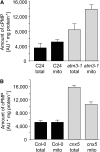A novel role for Arabidopsis mitochondrial ABC transporter ATM3 in molybdenum cofactor biosynthesis
- PMID: 20164445
- PMCID: PMC2845412
- DOI: 10.1105/tpc.109.068478
A novel role for Arabidopsis mitochondrial ABC transporter ATM3 in molybdenum cofactor biosynthesis
Abstract
The molybdenum cofactor (Moco) is a prosthetic group required by a number of enzymes, such as nitrate reductase, sulfite oxidase, xanthine dehydrogenase, and aldehyde oxidase. Its biosynthesis in eukaryotes can be divided into four steps, of which the last three are proposed to occur in the cytosol. Here, we report that the mitochondrial ABC transporter ATM3, previously implicated in the maturation of extramitochondrial iron-sulfur proteins, has a crucial role also in Moco biosynthesis. In ATM3 insertion mutants of Arabidopsis thaliana, the activities of nitrate reductase and sulfite oxidase were decreased to approximately 50%, whereas the activities of xanthine dehydrogenase and aldehyde oxidase, whose activities also depend on iron-sulfur clusters, were virtually undetectable. Moreover, atm3 mutants accumulated cyclic pyranopterin monophosphate, the first intermediate of Moco biosynthesis, but showed decreased amounts of Moco. Specific antibodies against the Moco biosynthesis proteins CNX2 and CNX3 showed that the first step of Moco biosynthesis is localized in the mitochondrial matrix. Together with the observation that cyclic pyranopterin monophosphate accumulated in purified mitochondria, particularly in atm3 mutants, our data suggest that mitochondria and the ABC transporter ATM3 have a novel role in the biosynthesis of Moco.
Figures









Similar articles
-
Genetic dissection of cyclic pyranopterin monophosphate biosynthesis in plant mitochondria.Biochem J. 2018 Jan 31;475(2):495-509. doi: 10.1042/BCJ20170559. Biochem J. 2018. PMID: 29247140 Free PMC article.
-
An allelic mutant series of ATM3 reveals its key role in the biogenesis of cytosolic iron-sulfur proteins in Arabidopsis.Plant Physiol. 2009 Oct;151(2):590-602. doi: 10.1104/pp.109.143651. Epub 2009 Aug 26. Plant Physiol. 2009. PMID: 19710232 Free PMC article.
-
Molybdenum cofactor biosynthesis and molybdenum enzymes.Annu Rev Plant Biol. 2006;57:623-47. doi: 10.1146/annurev.arplant.57.032905.105437. Annu Rev Plant Biol. 2006. PMID: 16669776 Review.
-
Identification of a protein-protein interaction network downstream of molybdenum cofactor biosynthesis in Arabidopsis thaliana.J Plant Physiol. 2016 Dec 1;207:42-50. doi: 10.1016/j.jplph.2016.10.002. Epub 2016 Oct 19. J Plant Physiol. 2016. PMID: 27792900
-
Molybdoenzymes and molybdenum cofactor in plants.J Exp Bot. 2002 Aug;53(375):1689-98. doi: 10.1093/jxb/erf038. J Exp Bot. 2002. PMID: 12147719 Review.
Cited by
-
Regulating Subcellular Metal Homeostasis: The Key to Crop Improvement.Front Plant Sci. 2016 Aug 5;7:1192. doi: 10.3389/fpls.2016.01192. eCollection 2016. Front Plant Sci. 2016. PMID: 27547212 Free PMC article. Review.
-
Micronutrient deficiency-induced oxidative stress in plants.Plant Cell Rep. 2024 Aug 12;43(9):213. doi: 10.1007/s00299-024-03297-6. Plant Cell Rep. 2024. PMID: 39133336 Review.
-
Tonoplast-localized Abc2 transporter mediates phytochelatin accumulation in vacuoles and confers cadmium tolerance.J Biol Chem. 2010 Dec 24;285(52):40416-26. doi: 10.1074/jbc.M110.155408. Epub 2010 Oct 11. J Biol Chem. 2010. PMID: 20937798 Free PMC article.
-
The iron-sulfur cluster assembly machineries in plants: current knowledge and open questions.Front Plant Sci. 2013 Jul 24;4:259. doi: 10.3389/fpls.2013.00259. eCollection 2013. Front Plant Sci. 2013. PMID: 23898337 Free PMC article.
-
Chlamydomonas reinhardtii-A Reference Microorganism for Eukaryotic Molybdenum Metabolism.Microorganisms. 2023 Jun 27;11(7):1671. doi: 10.3390/microorganisms11071671. Microorganisms. 2023. PMID: 37512844 Free PMC article. Review.
References
-
- Akaba S., Seo M., Dohmae N., Takio K., Sekimoto H., Kamiya Y., Furuya N., Komano T., Koshiba T. (1999). Production of homo- and hetero-dimeric isozymes from two aldehyde oxidase genes of Arabidopsis thaliana. J. Biochem. 126: 395–401 - PubMed
-
- Allikmets R., Raskind W.H., Hutchinson A., Schueck N.D., Dean M., Koeller D.M. (1999). Mutation of a putative mitochondrial iron transporter gene (ABC7) in X-linked sideroblastic anemia and ataxia (XLSA/A). Hum. Mol. Genet. 8: 743–749 - PubMed
-
- Balk J., Lobréaux S. (2005). Biogenesis of iron-sulfur proteins in plants. Trends Plant Sci. 10: 324–331 - PubMed
Publication types
MeSH terms
Substances
LinkOut - more resources
Full Text Sources
Other Literature Sources
Molecular Biology Databases

